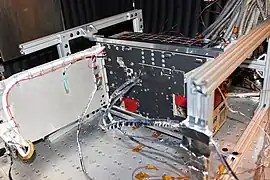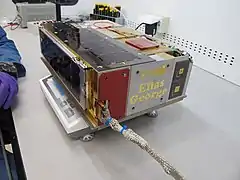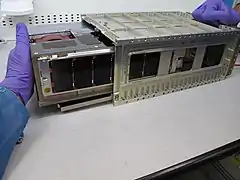.jpg.webp) The CuSP Team delivers the Cubesat to NASA's Kennedy Space Center. Shown are (left to right) Mike Epperly, Project Manager, Don George, Mission Engineer, and Chad Loeffler, Flight Software Engineer. | |
| Names | CuSP |
|---|---|
| Mission type | Technology demonstration, reconnaissance, Space Weather |
| Operator | Goddard Space Flight Center (GSFC) |
| Mission duration | 81 minutes 6 seconds |
| Spacecraft properties | |
| Spacecraft | CubeSat |
| Spacecraft type | 6U CubeSat |
| Bus | SwRI Custom Design |
| Manufacturer | Southwest Research Institute (SwRI) |
| Launch mass | 10.2 kg (22 lb) |
| Dimensions | 10 cm × 20 cm × 30 cm |
| Power | 45.46 watts |
| Start of mission | |
| Launch date | 16 November 2022, 06:47:44 UTC[1] |
| Rocket | SLS Block 1 |
| Launch site | KSC, LC-39B |
| Contractor | NASA |
| End of mission | |
| Last contact | 16 November 2022 |
| Orbital parameters | |
| Reference system | Heliocentric orbit |
| Flyby of Moon | |
| Instruments | |
| Suprathermal Ion Spectrograph (SIS) Miniaturized Electron and Proton Telescope (MERiT) Vector Helium Magnetometer (VHM) | |
CubeSat for Solar Particles (CuSP) was a low-cost 6U CubeSat to orbit the Sun to study the dynamic particles and magnetic fields.[2][3] The principal investigator for CuSP is Mihir Desai, at the Southwest Research Institute (SwRI) in San Antonio, Texas.[2] It was launched on the maiden flight of the Space Launch System (SLS), as a secondary payload of the Artemis 1 mission on 16 November 2022.[1][4]
Following deployment from the Artemis launch adaptor, contact with the spacecraft showed that it successfully stabilized and deployed its solar arrays, but after the initial 57 minute 27 second radio contact, no further contact was established, however the search is still on. Blind commanding will be performed to stabilize the spacecraft should it still be functioning. [5] No contact has been established as of September 25, 2023 and NASA will not fund further attempts at contact.
Objective
Measuring space weather that can create a wide variety of effects at Earth, from interfering with radio communications to tripping up satellite electronics to creating electric currents in power grids, is of importance. To create a network of space weather stations would require many instruments scattered throughout space millions of miles apart, but the cost of such a system is prohibitive.[2] Though the CubeSats can only carry a few instruments, they are relatively inexpensive to launch because of their small mass and standardized design. Thus, CuSP also was intended as a test for creating a network of space science stations.[2]
The CuSP team
CuSP Spacecraft Team:[6]
Dr. Mihir Desai, PhD: Principal Investigator
Mike Epperly: Project Manager
Dr. Don George, PhD: Mission System Engineer
Chad Loeffler: Flight Software Engineer
Raymond Doty: Spacecraft Technician
Dr. Frederic Allegrini, PhD: SIS Instrument Lead
Dr. Neil Murphy, PhD: VHM Instrument Lead
Dr. Shrikanth Kanekal, PhD, MERiT Instrument Lead
Payload
This CubeSat carried three scientific instruments:[2][3]
- The Suprathermal Ion Spectrograph (SIS), is built by the Southwest Research Institute to detect and characterize low-energy solar energetic particles.
- Miniaturized Electron and Proton Telescope (MERiT), is built by the NASA's Goddard Space Flight Center and will return counts of high-energy solar energetic particles.
- Vector Helium Magnetometer (VHM), being built by NASA's Jet Propulsion Laboratory, will measure the strength and direction of magnetic fields.
- Propulsion
The satellite features a cold gas thruster system for propulsion, attitude control (orientation) and orbital maneuvering.[7]
Spacecraft bus
The spacecraft's bus consisted of:[6]
- SwRI Spacecraft Integrator: Design, Assembly, Integration and Test
- SwRI SATYR Command and Data Handling Unit
- SwRI Flight Software
- Clyde-Space AAC Electrical Power System
- BCR MPPT converters
- LiPo Batteries and
- Deployable and Fixed Solar Arrays
- VACCO MiPS Cold Gas Thruster
- Blue Canyon Technologies XACT ADCS with Integrated Thruster Control
- SwRI Spacecraft Structure Mechanical and Thermal (SMT)
- NASA JPL/SDL IRIS X-Band Deep Space Transponder
- NASA GSFC Mission Operations Center
- NASA Deep Space Network Ground Communication
Flight results - a qualified success
- After a successful launch of the SLS at 12:47 am ET, The Orion/ICPS performed a Trans-Lunar Injection and separated.
- Shortly thereafter, CuSP was deployed from its launch canister.
- Twenty-three minutes after deployment, DSN received Open Loop Receiver (OLR) telemetry from CuSP indicated it had booted up, detumbled, deployed solar arrays, and assumed a SAFE, Sun-pointing, orientation.
- It was operating perfectly until...
- OLR monitoring of the radio signal indicated that the transmitter stopped suddenly after transmitting for 1 hour and 15 minutes.
- No cause has been determined for this end of transmission.
- Multiple attempts to receive additional signals from the spacecraft failed, and no further contact has yet been made.
- The CuSP team fully investigated a sudden battery temperature increase and found it was a telemetry failure. This was verified by comparing redundant indications of several parameters. The redundant indications did not show the suspected excursion.
- The CuSP team fully investigated an anomalous high IRIS Radio temperature and found it to only be a GSE scaling problem.
- Additional contact attempts are planned during the third quarter of 2023.
Gallery
 CuSP is instrumented and placed in the Thermal Vacuum Chamber.
CuSP is instrumented and placed in the Thermal Vacuum Chamber. Dr. Mihir Desai, Principal Investigator, seen with the CuSP
Dr. Mihir Desai, Principal Investigator, seen with the CuSP Dr. Don George, Mission Engineer, testing the Electrical Power System (EPS) on the CuSP.
Dr. Don George, Mission Engineer, testing the Electrical Power System (EPS) on the CuSP. Dr. Gumby presenting the post deployment sequence of operations of CuSP to a NASA review panel.
Dr. Gumby presenting the post deployment sequence of operations of CuSP to a NASA review panel. CuSP weighs-in at a 'wet mass' of 10.2 kg, well within the 14 kg mass limit.
CuSP weighs-in at a 'wet mass' of 10.2 kg, well within the 14 kg mass limit. The 'Purple Hands' verify that CuSP fits into its dispenser. This dispenser pushes CuSP out of the launch vehicle.
The 'Purple Hands' verify that CuSP fits into its dispenser. This dispenser pushes CuSP out of the launch vehicle. The Principal Technician for CuSP, Raymond Doty, makes final 'Pack and Ship' preparations for CuSP.
The Principal Technician for CuSP, Raymond Doty, makes final 'Pack and Ship' preparations for CuSP.
See also
The 10 CubeSats flying in the Artemis 1 mission
- Near-Earth Asteroid Scout by NASA was a solar sail spacecraft that was planned to encounter a near-Earth asteroid (mission failure)
- BioSentinel is an astrobiology mission
- LunIR by Lockheed Martin Space
- Lunar IceCube, by the Morehead State University
- CubeSat for Solar Particles (CuSP)
- Lunar Polar Hydrogen Mapper (LunaH-Map), designed by the Arizona State University
- EQUULEUS, submitted by JAXA and the University of Tokyo
- OMOTENASHI, submitted by JAXA, was a lunar lander (mission failure)
- Cislunar Explorers, Cornell University, Ithaca, New York
- Earth Escape Explorer (CU-E3), University of Colorado Boulder
References
- 1 2 Roulette, Joey; Gorman, Steve (16 November 2022). "NASA's next-generation Artemis mission heads to moon on debut test flight". Reuters. Retrieved 16 November 2022.
- 1 2 3 4 5 "Heliophysics CubeSat to Launch on NASAs SLS". NASA. 2 February 2016. Retrieved 9 March 2021.
 This article incorporates text from this source, which is in the public domain.
This article incorporates text from this source, which is in the public domain. - 1 2 Messier, Doug (5 February 2016). "SwRI CubeSat to Explore Deep Space". Parabolic ARC. Retrieved 9 March 2021.
- ↑ Harbaugh, Jennifer (23 July 2021). "Artemis I CubeSats will study the Moon, solar radiation". NASA. Retrieved 22 October 2021.
- ↑ Hill, Denise (December 8, 2022). "Artemis I Payload CuSP CubeSat Has Apparently Failed," NASA Press release (alternate link: SpaceRef). Retrieved 8 Dec. 2022.
- 1 2 George, Don (21 April 2016). "The CuSP interplanetary CubeSat mission" (PDF). California Polytechnic State University.
- ↑ "CuSP Propulsion System". VACCO Industries. 11 August 2017. Retrieved 20 August 2022.